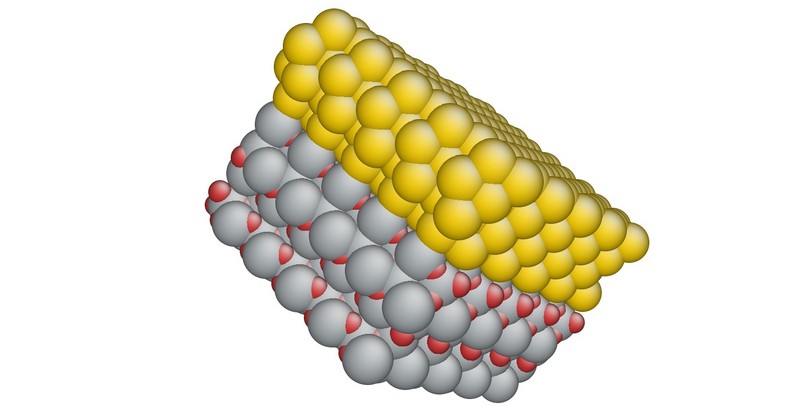Description
|
Many problems in materials science require the simulation of combined systems like oxides, metals and semiconductors (see Fig. 1). In Project B.1 interaction potentials for oxides are to be developed and implemented in our Code IMD- With this tool we will study the material failure of oxide-metals interfaces under mechanical and thermal loads.
The project aims at the simulation of multicomponent nanoscale systems. In semiconductor devices insulating layers of oxides are in contact with metallic conducting paths. Understanding the behaviour of such combined systems under mechanical and thermal loads is of high relevance. The current molecular dynamic codes normally do not support interaction potentials for oxides simultaneously with interactions for metals and semiconductors.
For this reason our molecular dynamics code IMD is to be enabled to handle also interactions for oxides. These are long-range Coulomb and dipole forces. The potential model, which has to be implemented should be sufficiently accurate for quantitatively correct simulations and well portable. On the other hand the computation of the forces should be also efficient and well scalable to allow routine simulations of many millions of particles. The required force fields are generated by extension of our force-matching program potfit.
Also essential is the correct treatment of the charge distribution on metal-oxide interfaces. The valencies of the metal atoms increase from zero to a finite value as one approaches the interface from the pure metal side. To model this change different methods exist, among them the one of Streitz and Mintmire. After critical evaluation we intend to implement the most accurate and efficient one into IMD.
The goal is to allow simulations of oxide materials and combined metal/metal-oxide systems in such dimensions that are nowadays common for pure metals and for covalent bonded systems in material science.
State of the art
For metals and covalent materials in common molecular dynamics codes (especially in IMD) are realized:
-
system size > 10^7 atoms
-
simulation times up to nanoseconds because of good scalability in the number of CPUs
-
accurate and efficient potential models
The challenge is to get also same datas for metal-oxides. For the accurate treatment of long range electrostatic interactions the so-called Wolf summation [1] exists, which is a direct summation with linear scaling properties. An interaction model which takes the polarizability of the different ions into account has been developed by Tagney and Scandalo [2].
To describe in the simulation for a metal which is in contact with his oxide the method of Streitz and Mintmire [3] can be applied. The valencies are determined by minimization of the electrostatic energy. Electrostatic effects on the interfaces can be descriced correctly.
Literatur
[1] D. Wolf, P. Keblinski, S. R. Phillpot, und J. Eggebrecht, J. Chem. Phys. 110, 8254 (1999).
[2] P. Tangney und S. Scandolo, J. Chem. Phys. 117, 8898 (2002).
[3] F. H. Streitz und J. W. Mintmire, Phys. Rev. B 50(16), 11996 (1994).


